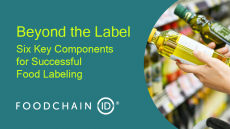Canada reveals allergen labeling plans
Health Canada estimates that about 5 to 6 percent of young children and 3 to 4 percent of adults are affected by food allergies. In addition, it says that about one percent of Canadians have celiac disease, an autoimmune disorder with symptoms that are triggered by gluten, the protein in wheat, rye, barley and spelt. Currently the only available treatment for food allergies and celiac disease is complete avoidance of the foods that cause reactions.
The new labeling regulations will require labels to clearly identify food allergens, gluten sources, and sulphites either in the list of ingredients or at the end of the list of ingredients with the statement "Contains: . . . ''. The regulation covers peanuts, eggs, milk, tree nuts, wheat, soy, sesame seeds, seafood, sulfites, and mustard.
Established in 1994, the existing Canadian system for labeling allergens in packaged foods only ever applied on a voluntary basis and no specific on-pack wording was established for those manufacturers and importers that do choose to include precautionary allergen labeling. The only guidelines were that the wording was “truthful, clear and non-ambiguous”, and that an allergen warning should not be a substitute for good manufacturing practices. Nevertheless, Health Canada had called on industry to take proactive steps to improve the labeling of food allergens and gluten sources until regulatory amendments were enacted.
Canada’s Minister of Health Leona Aglukkaq said in a statement: "Our Government is committed to protecting children and families from dangerous products, and this is clear from the measures we have taken in our new Consumer Product Safety Act. All parents want to have confidence in the food they are serving their families, and these changes to food labels will make it easier for parents of children with food allergies to identify potentially harmful, if not fatal, ingredients in foods."
Food manufacturers will have until August 4, 2012 to comply with the new labeling regulations.
A summary of the labeling requirements is available here.















